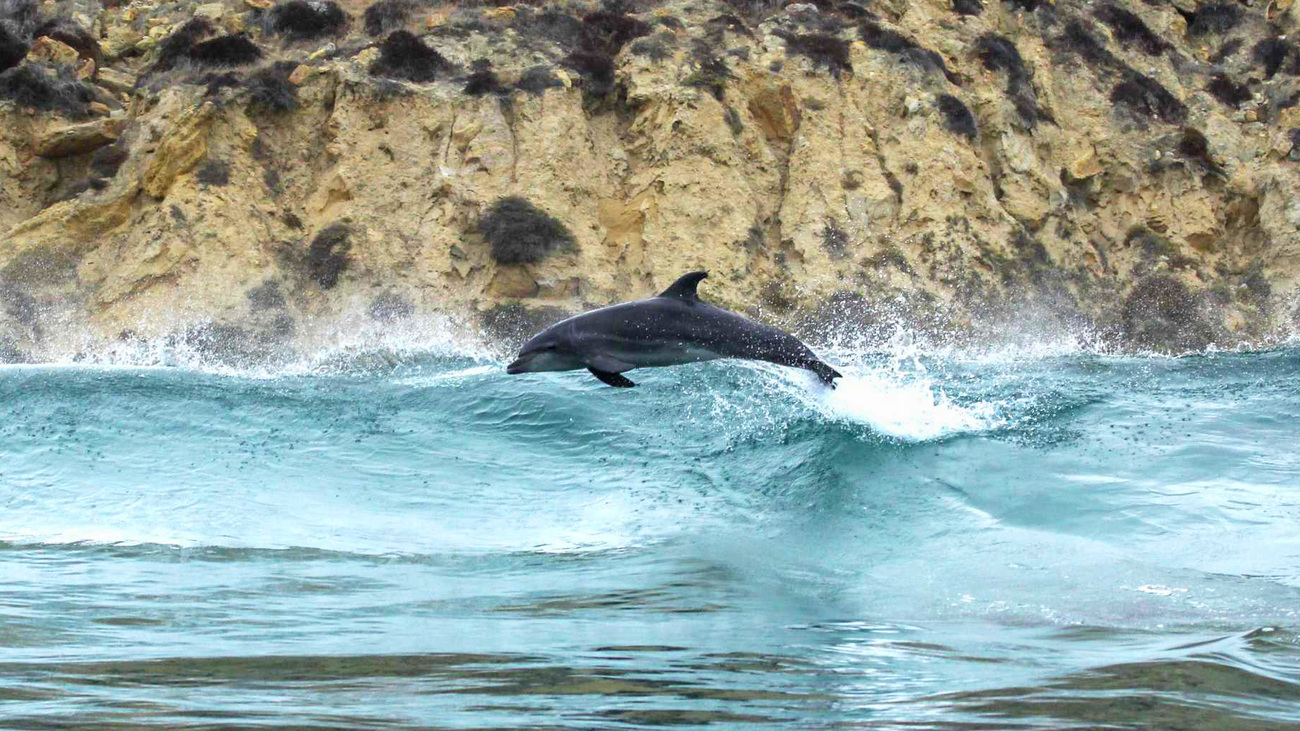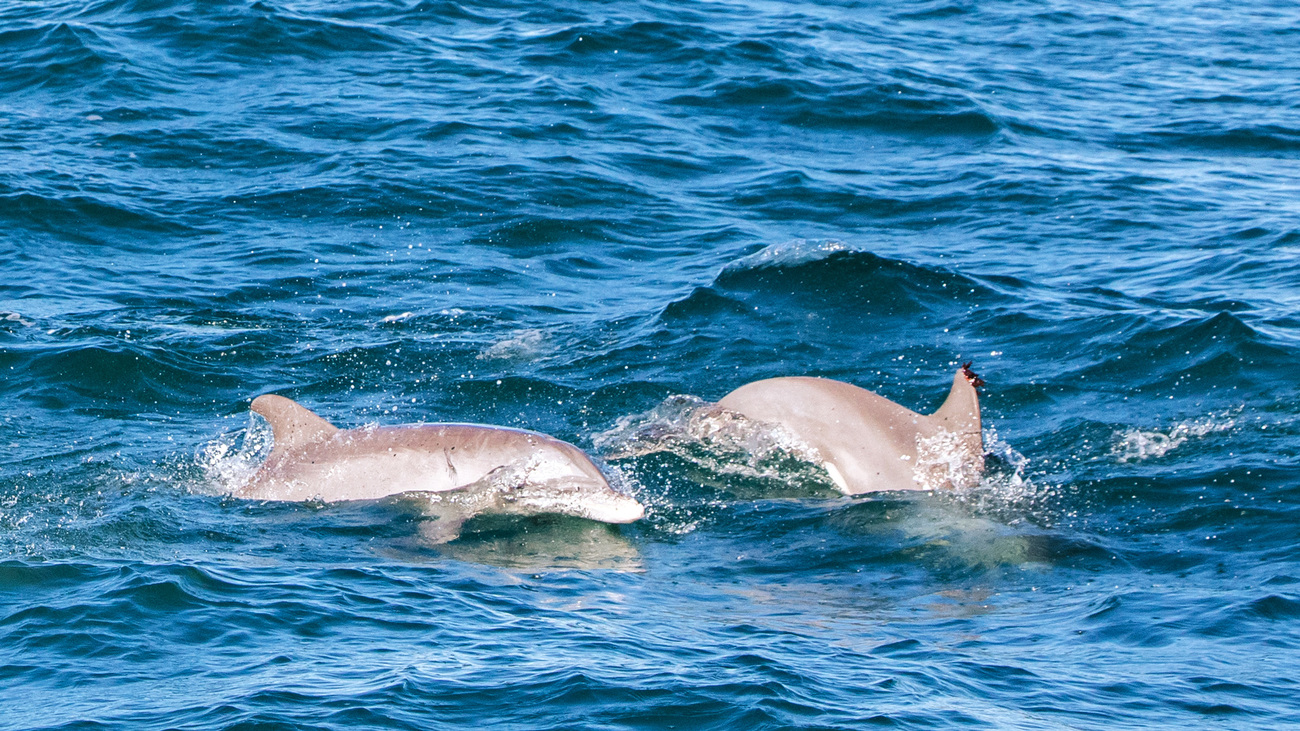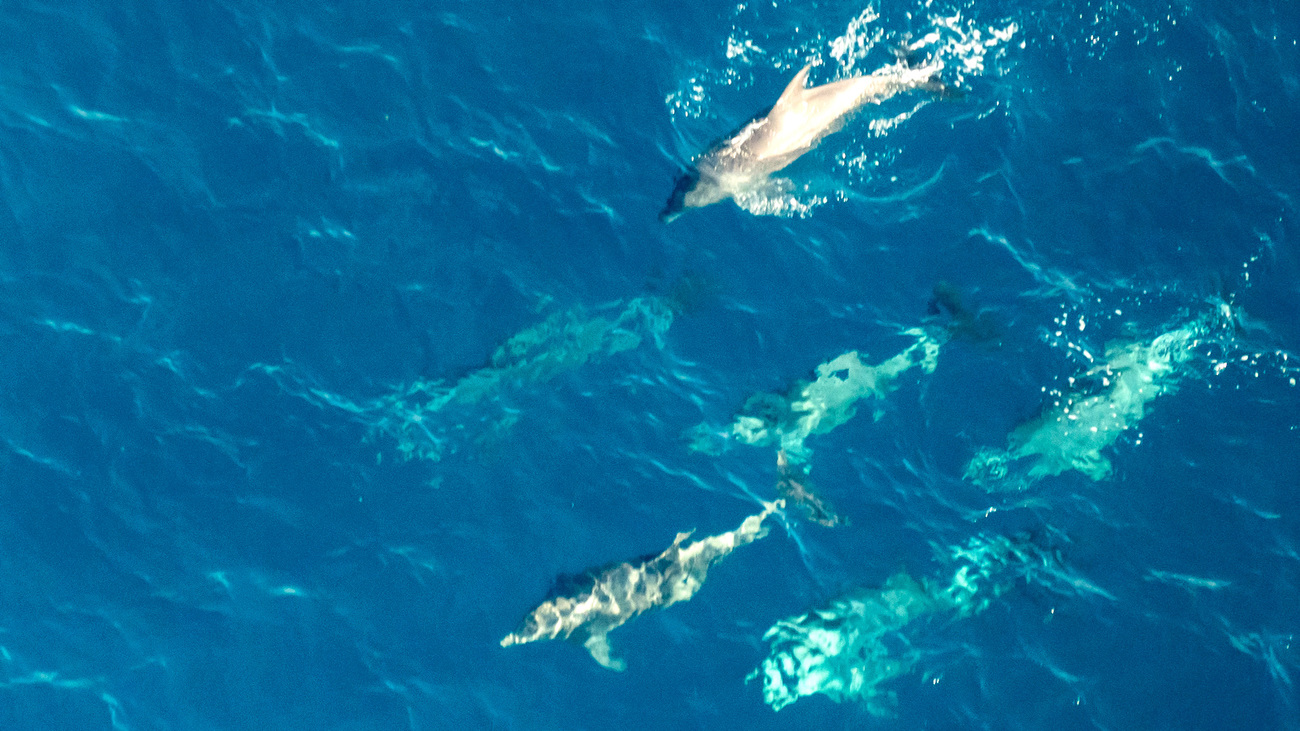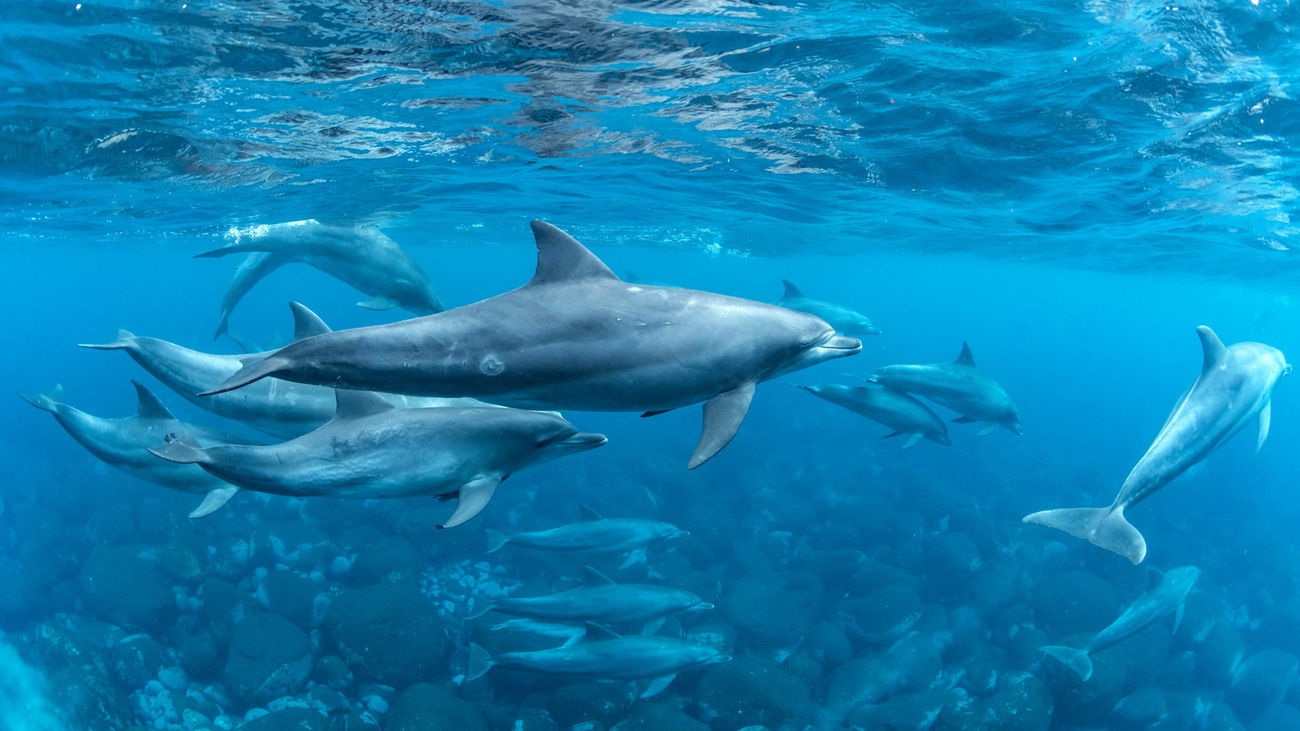Bottlenose dolphins
Bottlenose dolphins are one of the most widely recognized cetaceans in the world. They’re known for their distinctive bottle-shaped snouts, which inspired their name, as well as their curved mouths that resemble smiles. Bottlenose dolphins are dolphins of the genus Tursiops, which includes three distinct species.
These dolphins have sleek, streamlined bodies that are ideally adapted to navigating the open oceans with great speed and agility. They can leap out of the water as high as 6 meters (20 feet) into the air and reach speeds of up to 35 kilometers per hour (22 miles per hour).
Despite living in the ocean, bottlenose dolphins need to come up to the surface to breathe air. They breathe through a blowhole located on top of their heads, which they can open above the water’s surface and close when submerged. These fascinating marine mammals can hold their breath for around seven minutes. Bottlenose dolphins are a dark grey to bluish-grey on the dorsal side, which fades into a lighter grey on their underside. They’re also characterized by their tall, curved dorsal fins, which can often be spotted emerging from the ocean’s surface.
Adult bottlenoses typically grow to 2.5 to 3 meters (8 to 10 feet) long, weighing anywhere from 135 to 300 kilograms (300 to 660 pounds). In general, male bottlenose dolphins are larger than females. Bottlenose dolphins are found all around the world, living in both tropical and temperate oceans. There are various types of bottlenose dolphins, including the common bottlenose, Indo-Pacific bottlenose, Black Sea bottlenose, and Southern Australian bottlenose.
The bottlenose dolphin is considered to be among the smartest animals on the planet, as they have the longest social memories of any nonhuman species and the ability to recognize their own reflections. They’re very curious creatures, often approaching people to investigate and sometimes even interact.
Bottlenoses are a playful and social species, known for their acrobatic displays that include leaps, flips, and riding the bow waves of boats. These behaviors help to make up a complex social structure that allows them to form particularly strong bonds within groups of 10 to 15 bottlenose dolphins, known as pods. Within these pods, dolphins play, hunt, and work together to raise their young.
These intelligent marine mammals are excellent communicators, using distinct squeaking, squawking, and whistling sounds to convey information to one another. Each dolphin has a unique whistle used to identify itself, similar to how humans use names. They also use echolocation to navigate their surroundings, emitting high-frequency clicking sounds which echo back off of objects. Echolocation enables dolphins to identify the locations of objects and food sources, including their sizes, shapes, speeds, and distances.
Bottlenose dolphins can live anywhere from 40 to 60 years old, with females usually outliving males. They reach an age of sexual maturity between the ages of 5 and 15, though females mature faster than males. The gestation period for the bottlenose dolphin lasts around 12 months, with females birthing calves every 3 to 6 years. A bottlenose calf tends to nurse with its mother’s milk for around 20 months after birth, sticking with their mothers to learn essential survival skills for the next 3 to 6 years.
Bottlenoses are opportunistic predators, eating a variety of fish species and some cephalopods such as squid and octopus. They employ a range of hunting techniques, from individual foraging to team efforts that involve coordinated movements to herd schools of fish for easier capture.
These dolphins are integral to the health and balance of their marine ecosystems. Their feeding habits help to control the populations of prey species, which prevents the overgrazing of important marine vegetation. They also play a role in carbon sequestration in coastal areas, stimulating the growth of seagrass and other underwater vegetation through their movements and feeding habits.
What is a bottlenose dolphin’s scientific name?
There are three species of bottlenose dolphins, each with their own scientific name. The common bottlenose dolphin, Tursiops truncatus, is found worldwide in tropical and temperate oceans.
The Indo-Pacific bottlenose dolphin’s scientific name is Tursiops aduncus; it is found in the Indian and Western Pacific Oceans.
Tursiops erebennus is Tamanend’s bottlenose dolphin; it inhabits the waters off the coast of the eastern US and has most recently been recognized as a distinct species.
The Black Sea bottlenose dolphin, a subspecies of the common bottlenose dolphin, is called Tursiops truncatus ponticus, found in the Black Sea. The Burrunan dolphin is known as Tursiops australis, though it is still debated whether or not the Burrunan dolphin qualifies as its own species.
Are bottlenose dolphins endangered?
Common bottlenose dolphins are not endangered and are classed as least concern on the IUCN Red List. However, the Indo-Pacific bottlenose dolphin is classed as near threatened.
Where do bottlenose dolphins live?
Bottlenose dolphins are widespread across the globe. Their distribution is influenced by water temperature, food availability, and other ecological factors. Bottlenoses are frequently found in coastal waters, including bays, estuaries, and lagoons, where there is an abundance of food. They also inhabit both tropical and temperate open oceans, including the Atlantic, Pacific, and Indian Oceans. Sometimes, bottlenoses can be spotted in river estuaries, especially in parts of Florida.
Threats
Bottlenose dolphins, like many marine species, face a range of threats to their survival and well-being due to human activities and natural factors. However, despite these threats, their populations remain stable, helped by safeguarding laws in several places.

Fishing
In some parts of the world, bottlenose dolphins have been hunted for their meat and other body parts for consumption or use as fishing bait. They are also targeted for capture for the live animal trade. In the US, as well as some other countries around the world, the common bottlenose dolphin is protected by safeguarding laws, such as the Marine Mammal Protection Act of 1972. These restrictions were put in place to prevent the continued decline of the bottlenose dolphin population seen in the last century, as well as in acknowledgment of the intelligence of these marine mammals.
Bottlenose dolphins can also sometimes become caught in fishing nets and gear as bycatch. This can result in severe injuries or even death.
Human activity
Inhabiting coastal waters means that bottlenose dolphins are impacted by human activities. Heavy boat traffic increases the chances of collisions between vessels and dolphins, resulting in injuries or fatalities. The noises from ships can also disrupt dolphins’ communication and echolocation.
Their proximity to humans also means that bottlenoses are affected by runoff from chemical pollutants, including heavy metals and industrial chemicals. These chemicals can accumulate in the food web and eventually be consumed by dolphins, resulting in reproductive issues and compromised immune systems.
Plastic pollution also poses a threat to the well-being of bottlenose dolphins. Ingestion of plastic debris can be lethal, and dolphins may accidentally consume plastic while feeding.
FAQs
What do bottlenose dolphins eat?
The bottlenose dolphin diet consists of a wide range of prey species. The specific types of prey they consume can vary based on their location and the availability of food. Bottlenose dolphins primarily eat fish, including mullet, mackerel, herring, sardines, and various types of bream.
They’re also skilled at hunting cephalopods like squid and octopus. In some regions, bottlenose dolphins may eat crustaceans such as crabs and shrimp, as well as other marine life including small rays and even sharks.
How many bottlenose dolphins are left in the world?
Bottlenose dolphins are not an endangered species and are thought to have a stable population. While it’s not known exactly how many bottlenose dolphins there are in the world, it’s estimated that there are around 750,000. However, it’s important to note that some regions haven’t been surveyed for abundance estimations and that some of the estimations are outdated.
How much does a bottlenose dolphin weigh?
The average bottlenose dolphin can weigh anywhere from 135 to 300 kilograms (300 to 660 pounds).
How big are bottlenose dolphins?
Bottlenose dolphins can grow as long as 2.5 to 3 meters (8 to 10 feet) in length, with males generally growing larger than females.

How long do bottlenose dolphins live?
Bottlenose dolphins can live for at least 40 years, with some female dolphins outliving males to ages of 60 or higher.
How fast can bottlenose dolphins swim?
The bottlenose dolphin will swim routinely at speeds of around 5 to 11 kilometers per hour (3 to 7 miles per hour). However, they can swim a lot faster, sometimes reaching speeds of up to 35 kilometers per hour (22 miles per hour).
How do bottlenose dolphins communicate?
As one of the most intelligent creatures in the world, bottlenose dolphins are very sophisticated communicators, rivaling even the great apes. Communication is key for dolphins, as it allows them to form strong bonds within their pods, as well as coordinate group activities and even express their emotions.
The two main types of communication that dolphins use are vocalizations and body language. Bottlenose dolphins make rapid clicking sounds, known as echolocation clicks, for navigation and locating prey. These clicks are emitted from their foreheads and help them gain an understanding of their environment through echoes.
Bottlenoses also produce whistles, which are used for communication between individuals. Each dolphin has a unique whistle, often referred to as a signature whistle, which helps in individual identification and maintaining social bonds. They’re also known to squeak and squawk.
Bottlenose dolphins also make use of various body postures to convey emotions and intentions, as well as play with one another and form social bonds. They’ve been observed to leap high into the air, slap the water with their tails, blow bubbles, and even butt heads.
These magnificent creatures are thought to have the longest social memories of any nonhuman, capable of recognizing the identifying whistles of dolphins with which they haven’t interacted for around 20 years.
How are bottlenose dolphins affected by climate change?
While bottlenose dolphins are not endangered, they are still experiencing the effects of climate change. Rising sea levels, ocean acidification, and altered ocean currents can all have indirect effects on bottlenose dolphins. These changes can impact their habitat, as well as the distribution and abundance of the dolphins’ prey species, making it more challenging for them to find food.
Our work
IFAW has been a key player in marine mammal and dolphin rescue for over two decades. Our Marine Mammal Rescue team is renowned for creating a world-leading cetacean stranding program that emphasizes health assessments and treatments to swiftly return these animals to the ocean. Our approach has increased the release rate of stranded dolphins from 15% to nearly 80% since 1998.
In 2022, our team saved a stranded bottlenose dolphin on Cape Cod, a location prone to live cetacean strandings. This remarkable rescue involved 27 responders working together to carry the massive 720-pound dolphin back to deep waters. Using temporary satellite tags, we tracked the dolphin post-release, confirming its return to a known bottlenose dolphin habitat far offshore. Over the past 23 years, we’ve been able to rescue, treat, and release more than 70% of viable candidates back into the wild, proving that these animals not only survive but thrive after their release.
IFAW’s initiatives include the creation of our first-of-its-kind Dolphin Rescue Center for rehabilitating stranded cetaceans, global training for first responders, reduction of ocean noise, lobbying for slower vessel speeds, advocating for sustainable fishing practices, and working to diminish bycatch and entanglements. We also recently
Through these efforts, we aim to enhance the chances of rescued marine mammals returning to safe ocean environments while addressing various threats to their survival.

How can you help?
Bottlenose dolphins face threats from fishing and other human activities, but IFAW is working to protect them. Learn more about our Marine Mammal Rescue program.
